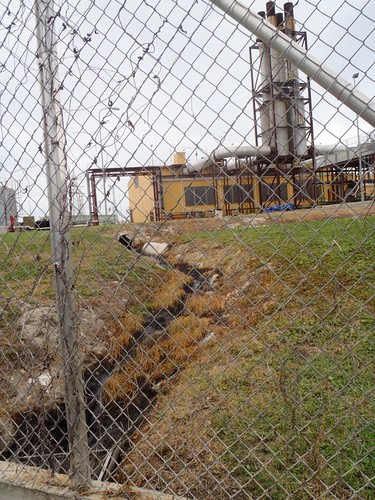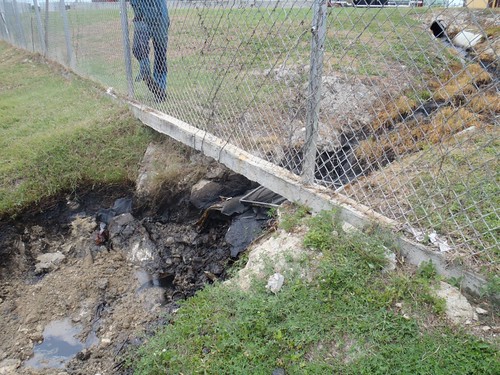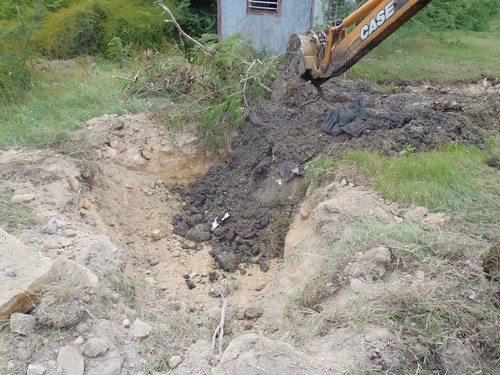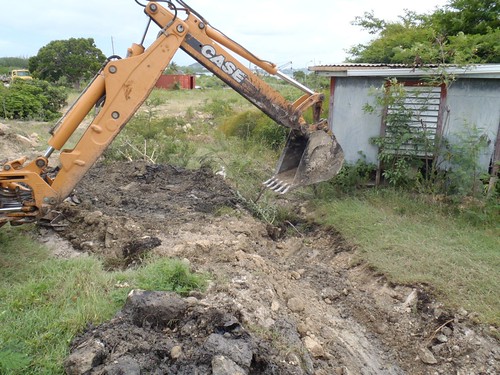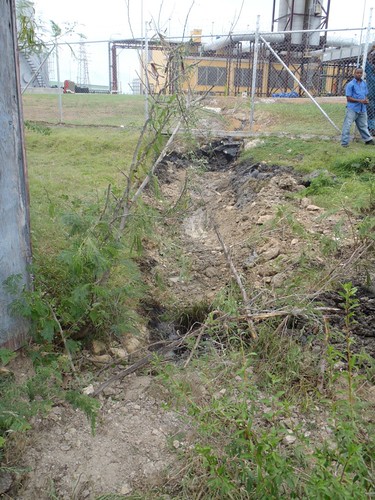Finally the government at the time managed to get hold of what had been described as a reconditioned desalination plant. This solved the water shortage problem as well as also another problem we had been having with power generation. The plant produced water and electricity at the same time. It was as if we had been taken into a new stage in our island's development. Clean water was now there for everyone.
However, with as many problems that this new plant solved there were as many new problems created. As you would expect, the desalination plant was on the coast and it was going to be the start of a generation of hidden environmental problems. The purpose of this blog post today is to highlight one of these problems which is simply the contamination of our marine environment from the plant's used engine oil and to also show that the old desalination plant isn't the lone contributor Antigua's generational oil spills into the ocean.
Getting rid of toxic waste has never been easy for any country, but Antigua and Barbuda seems to be unique in their approach to toxic waste. I won't speak about all the other dangerous forms of toxic waste that ultimately get into the ocean because i don't have the space or time today on my birthday. Suffice to say, that we are as bad if not worse than most other third world island nations.
OIL - Antigua surprisingly has a Ministry of Environment but seems to have no official environmental policy. The Environment Division has no legislative powers at all and can only ever offer their advice and suggestions to the Minister and other Government offices. They are by design less effective than someone standing on a soap box on market street. Baldwin Spencer and his UPP government have plenty to answer for environmentally. Like many others, I voted them into power originally because of their huge chapter on all the nice environmental things they promised in their winning manifesto. These promises were summed up in their campaign slogan of "What was wrong would be made right", and to this day nearly 8 years later i am still waiting for one single shimmer of a sign that the UPP may be interested in making a single environmental problem change from being wrong to right. Oil is one of the biggest problems in Antigua environmentally. There are no rules or regulations that I know of that deal with waste oil, and as a result most of the islands waste oil ends up in the ocean eventually. Ewart Harny of Harney Motors is the main man behind a fairly new company that processes waste oil into usable fuel which is similar to diesel. This fantastic company is the only recycling program on the island for used engine oil and I am delighted that it exists here. All of the waste oil from my boats goes to that plant and together with the rest of the oil that they collect, it is eventually put back to use in trucks, buses, vans, SUVs, boats and many other diesel using vehicles. All we need now is a series of hard core laws with real punishment for people who discard used oil, incentives for other plants like Mr. Harney's to be set up (read here), an increase in the tax on the imported diesel, a good price control mechanism on fuel oil derived from wast oil, and a very good collection system for waste engine oil. If these things would be encouraged, the island would be so much better off and photos like this would be a thing of the disgusting past.
This kind of slimy black beach isn't what Antigua is famous for at all is it? Yet, this isn't the only one. Within a few miles of Antigua's most prestigious island resort, Jumby Bay, there are several beaches where you can be lubricated not by sunscreen and rum punch, but by cancer causing toxic sludge like you see also here:
Since the ALP government purchased the desalination plant, the hazardous waste oil together with all the harmful chemicals has been getting into the ground up at Crabbs Peninsula and slowly making it's way into the ocean and I think ultimately into our food. I have also found out that even before the desalination plant was set up at Crabbs there was a power generation plant there for over ten years. As with all fuel burning engines in Antigua, regular maintenance requires oil changes. I assume that the Antigua Public Utilities Authority (APUA) does similar service on their engines even if it's not a consistent as it should be judging from all the break downs, but historically their used waste engine oil is buried in the ground or just dumped into an open pit. In have heard that in some cases a "reservoir" is dug and plastic sheets are put down before the oil is dumped into these ponds.
In 2005 the infamous R. Alan Stanford purchased some land up at Crabbs to build a marina. These photos show some small test holes that were dug by the architects and contractors.


Shortly after each hole was dug, it slowly started to be filled with oil oozing out of the ground adjacent to it. According to a representative of the architectural firm OBM, "Stanford spent hundreds of thousands of dollars trying to remove the oil permanently from his site". Stanford didn't want any oil to be sitting below his property and an expert consultant was brought in to study the problem and to make recommendations. OBM says they have the report and have given me several photos from the report. One of the things they did was to dig a huge trench along the property line where it meets the APUA property and put in an impermeable membrane along it to stop further oil from leeching across from the government site. Then the large trenches and holes that now had oil filling them were pumped dry each day until they finally stopped being filled from the surrounding land.
I think the time has come for the Environment Division and the Government to address the waste oil situation island wide and come up with a real policy.
First they have to start with Crabs. As you can see from this old Google Earth image, the oil slick coming off Crabbs is always there and has been there for years and years.
Here is another photo taken in 2008 which shows the constant oil slick:
Next time you take off in a plane and happen to bank to the south look out and you will see it. You can also see it when you are driving up Airport Road approaching "Sealy Bend". Of course you can always see it when you pass Crabbs in a boat. Here is another one I took on the weekend showing the same thin reflective, oil slick coming off of Crabbs right next to the APUA plant.
These days there are two different large scale producers of electricity up at the Crabbs Industrial area using huge heavy machines. APUA which runs both desalination and power production is one and the private APC is the other. As i mentioned earlier, Ewart Harney has a waste oil processing plant situated also up at Crabbs. Last week photos were taken of another type of oil spill coming from the area.
I was told my someone from APC that they had a major problem up at their plant recently which lead to "a quantity of oil" escaping into the cooling waters which flow down a canal into the mangroves there and ultimately into the sea seen here in an image taken from the 365Antigua article
On saturday a few of us went down in a small boat to the area where the oil ended up. Samples were collected and a video was shot together with an array of images. These have not been published, but it proves there was a recent oil spill despite the Coast Guard not being able to find it and various people and media questioning the leak.
I understand now after reading a piece in this Caribarena article that APC is saying that the leak wasn't from them which seems to be quite strange considering the photos which were posted on 365Antigua allegedly showing the spill and then people covering up the trail of oil coming from their plant. Here are some more of these telling photos:
As you can see, it is probably not unlikely that APC had something to do with this recent spill considering how much effort they went to to cover up their oily drain only hours after the helicopter photos were published and calls from the local media started coming in. I think this may have been a mistake made by one of the managers. That being said, APC did have some sort of malfunction and during normal periods of maintenance they do supply Haney's oil processing plant with their waste oil as i mentioned earlier and don't have a policy of dumping their oil. According to the Daily Observer article that mentioned this specific oil spill, the local Fisheries department was quoted as saying oil spills have nothing to do with them. This is strange since the entire area has been a marine protected area (NEMMA) under the Fisheries Act. Imagine what would have happened if their had been an oil spill within a marina park in the USA. I think we need some changes in our Fisheries department, but everyone knows this about as much as they know that Antigua needs some Environmental legislation changes. Something as simple as an "environmental inspector" up in the Crabbs Industrial area would be a step in the right direction. It's obvious that you can do whatever you want environmentally in this country and get away with it. (I can only think of one company that has ever gotten into minor trouble for an environmental issue.)
Although the oil spill from APC or whoever you want to blame for last weeks spill is terrible and would mean massive fines in a civilized country, the main problem as i see it is the constant, slow, spill or seepage of oil into the sea from Crabbs. Too many people know about this hazardous and long lasting spill and nobody is doing anything about it.
I am not a scientist and didn't do any more chemistry than i had do to in high school, but I am fairly sure that waste oil is extremely toxic especially when it is derived from a heavy fuel burning old desalination plant and or other large scale commercial applications. Without getting extremely technical you can get the general idea about why waste oil is hazardous by reading this link.
This link describes how chemicals which "include PCBs, VOCs, polyaromatic hydrocarbons (PAHs), petroleum hydrocarbons (PHCs) and lead" ended up in the water table and even in the drinking water because of a similar situation. Check this link.
This one speaks about a chemical that is often found in waste oil especially until the late 80s. In some parts of the Great Lakes: "Locally caught fresh water fish and shellfish are contaminated with PCBs and their consumption is restricted." Click here for more.
I hope that people who read this blog will share it with others and that one day someone who can actually take something that is "wrong" and make it "right" will be inspired to do more than just talk or write.
PS If you want more info on how to purchase recycled or processed oil in the form of diesel oil please call Ewart Harney at Harney Motors. Of course he will tell you how to get rid of your waste oil too.














